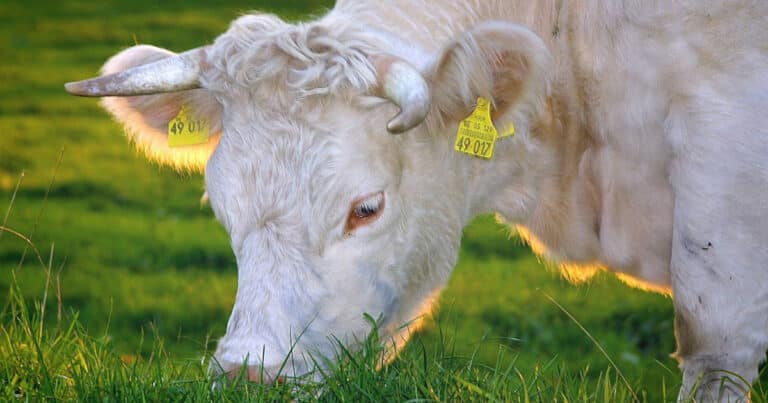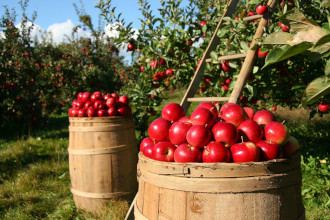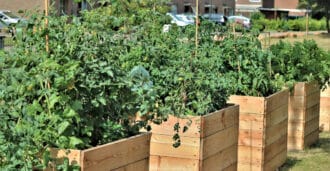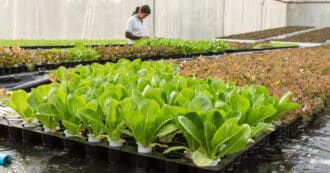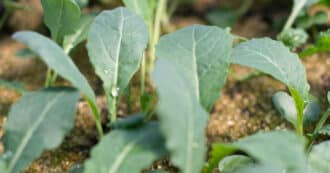By Elisheva Malomet and Ethan Keller – The proverbial saying “you are what you eat” bears extreme importance to global food production. The saying was originally meant to describe the connection between the food we consume and our mental and physical health.
The History of Food Production
We have been producing food for thousands of years. For millennia, humans used a hunter-gatherer system, living off of the land and moving from area to area across the world. Then, ten thousand years ago, agriculture was developed in the fertile crescent, a part of what is now known as the Middle East. This development allowed permanent communities to develop and population growth to increase. This sustenance farming resulted in the growth of small villages, and as time went on, more efficient ways to produce crops were developed to increase their size even more.
Then came the Arab Agricultural Revolution, which occurred roughly between 700-1100 C.E. During this time period, refined farming techniques were developed including two-field crop rotation, better irrigation systems as well as new ploughing methods. Increased crop yields meant farmers became prosperous by selling what they had, gaining capital and improving the overall community they were in.
In the mid 18th-early 19th centuries came the British Agricultural Revolution. The Norfolk four-field system allowed for even more nutrients to stay in the soil, preventing fields from becoming unproductive. The planting of turnips and clovers kept weeds away during the summer and winter harvests, while also acting as food for livestock, which increased the amount of meat produced. This all led to the conditions that preceded the Industrial Revolution. In both of these agricultural revolutions, the increased availability of food allowed for populations across the world to grow.
Finally, the Green Agricultural Revolution of the ’50s and ’60s arrived. With a more connected global population and said population increasing, new technologies needed to be developed. Thus came along pesticides and fertilizers. The pesticides decreased the amount of crop loss by insects and parasites, and the fertilizers allowed for even more crops to be grown.
Global Food Production
The issues that surround global food production are food security and distribution and the environmental impact of food and agriculture production. However, both the food production and its distrubution have huge impacts on the environment.
Food Insecurity
The Food and Agriculture Organization of the United Nations (FAO) collected and analyzed data on food production and consumption around the world from the years 1961 to 2013. Through data on caloric supply, this organization of the United Nations provided crucial information. That indicates food security around the world. The caloric availability delivered to households (including possible food waste) was 3100 kcal/person/day in countries across Europe, Oceania, and North America, and that countries across South Asia, Sub-Saharan Africa, and South America ranged in 2300-3000kcal/person/day.
Environmental Impacts of Food Production
Sustainable development should fuel the process that produces our food and the importance of sustainable development is discussed in our post “How to Optimize the Three Pillars of Sustainability.” Food production is reliant on our social, economic, and environmental needs and resources.
Unfortunately, current food production does not use sustainable practices and in fact, causes a lot of harm to the environment. Climate change is directly caused by dangerous, modern farming techniques, to land use, greenhouse gas emissions, and the overproduction of livestock and livestock feed.
The threat to biodiversity is also of extreme concern as a result of harmful food production processes. Currently, there is an extreme reliance on livestock for food production which is connected to the amount of land needed to generate agricultural production. With more land being used or large-scale farming projects, there is less room for animals, who are then in danger of extinction, to find and build natural habitats.
Animal products in food production
A huge part of our diet and food system today is based on the consumption of animal products. Meat, dairy, fish, and eggs are the normative food found on plates worldwide. Awareness of the negative impact of the food industry and the treatment of animals has grown in the past years due to groundbreaking documentaries and investigations. While the massive industry of factory farming is inhumane it also impacts the environment to a huge extent.
The meat industry has a significant environmental impact because of the amount of energy and land needed to produce meat. According to a study by Our World in Data, 77% of global farming land is used for growing feed for the animals. In addition, livestock and specifically cows, produce methane through their digestive system. Methane gas is released in a huge amount by livestock production, contributing to global green house gasses.
Meat production also has significant impacts on water consumption. A report on the state of the world’s land and water resources for food and agriculture, put out by the food and agriculture organization in 2011, showed that 70% of global freshwater is used for agricultural production. The impact on water pollution is also extreme. The pollution occurs mainly as a result of runoff from agricultural production into fresh streams and underground acquifers.
The beef industry specifically uses an exorbitant amount of water. According to the USGS (United States Geological Survey), it takes over 1,800 gallons of water just to produce a pound of beef, about 700 gallons to produce a pound of pork and 500 gallons for a pound of chicken. In comparison, it takes 100 gallons of water to produce a pound of fruit and just 40 gallons of water for a pound of vegetable production.
Dairy production has a similar impact to meat production. Dairy cows need to be fed a lot of feed which is grown in the form of cereals, legumes, and soybeans. A study done at the University of Minnesota in 2013 found that only 12% of the 36% of calories produced by global crop production contribute to the human diet, meaning that 24% of produced calories from crops go exclusively to the feeding of the livestock. This is an example of the extreme imbalance of the number of calories produced for animal products versus the number of calories that are actually contributing to human food consumption.
The production of fish and seafood is also a big contributor to harmful environmental problems. Overfishing, damage to marine life habitats, bycatch, plastic pollution from bottom trawling, habitat damage as well as fish feed production, which uses unsustainable levels of commercial fishing activity, are all examples of the extreme harm of the current fishing industry. Waste from fish farms also contribute to the pollution of local water sources and acquifers. Overfishing depletes natural resources while contributing to an increase in exhaust gases in the atmosphere from ships, processing plants, and refrigeration systems.
Eggs and poultry farming is also a big contributor to environmental problems due to the massive industrialization of this food process. In addition to the inhumane nature of this industry, egg and poultry farming contribute to greenhouse gas emissions.
Food Production and Greenhouse Gas Emissions
Greenhouse gas and carbon dioxide emissions are inexplicitly linked to the farming industry. Approximately 26% of global greenhouse gases are emitted because of agricultural processes. The emissions come from livestock, crop production, land clearing by logging, and all the processes by which the food reaches our plate.
As we mentioned previously, livestock, primarily cows, release methane through their digestive systems. Additionally, their manure is frequently used in farming techniques that also release emissions. Crop production and the general upkeep of farming through plowing and tractors also release carbon dioxide into the atmosphere. Large-scale ocean fishing operations also require harmful fuel to work and produce fish releasing carbon dioxide.
The land that agriculture needs also contributes to emissions. As land is converted for the needs of agricultural processes emissions are produced. Cutting forests for farmland, plowing practices and overturning soil cause significant environmental problems and emissions.
Food Production from the Farm to our Plate
The transport system that takes the food from the farms to our supermarkets requires fuel and energy that causes emissions. Harvesting, transportation, packaging production and wate, and the actual selling of the foods also clearly have an effect on emissions.
Food Waste
Food waste is one of the biggest contributors to the high amounts of emissions. The majority of food waste is due to the lack of storage in the countries the food has been delivered to. The food has used a huge amount of natural resources to be produced, a large quantity of resources to be delivered and eventually is left to rot far away from where it was produced. While it rots it produces even more greenhouse gasses.
Food Production and Fertilizers and Pesticides
Industrialized fertilizers are also generally composed of nitrogen and phosphorous which have the negative effect of releasing harmful nitrous oxide into the atmosphere. Pesticides increase efficiency in agriculture, but the cost they come at is high. The effect on humans is profound, but in food even more so. There is no way for crops to be void of any pesticide, though the question often is if the pesticides exceed the MRL (Maximum Residue Level). In most cases, fruits and vegetables are below the MRL though some, like spinach, exceeded the MRL 7.3% of the time. This is not good, of course, as pesticides and herbicides have a variety of effects on humans.
Then there is the impact on the environment. Surface and ground water contamination isn’t uncommon, with pesticides being detected in 99% of urban streams, and found in many ground water sources. And like fertilizers, pesticides interfere with fungi and microbes that live in the soil, and are important to the ecosystem.
Food Production Choices: Why Buy Locally? Why Buy Organic?
A oneliner often heard in environmentally conscious or sustainable communities is to “buy locally.” While this choice is extremely important for building a sustainable local economy the concern that food is traveling a far distance and thereby emitting a huge amount of carbon dioxide on the way to us is not the main problem. The carbon footprint of the food we consume comes primarily from the farming practices and the product itself, and not the way it gets to our supermarkets.
Organic food is produced without the use of chemicals or genetic modification. Pest and herb control is practiced through natural processes, but may be more labour intensive. Organic animals are animals that are free to live their life in an open field, as opposed to being factory farmed, whilst being fed wholesome, nutritious food.
There are many facets of organic food production that are beneficial to the environment. For example, growing monocultures deplete the soil of certain nutrients. Instead, crop rotations can be implemented so that soils have the chance to replenish nutrients via the growth of other crops. In general agricultural production there’s also the problem of artificial fertilizers, which when overused, are harmful to the soil and leach into waterways, polluting them. Using organic fertilizers, such as compost or animal manure, not only reduces the pollution of the land and water, but also increases the biodiversity in the soil, which in turn helps the crops grow. Additionally, organic farming, through crop rotation, tends to lead to an increased diversity in crops planted. This not only helps preserve different plant species, but also reduces susceptibility to plant disease outbreak, as different species have certain resistances.
Religious Teachings and the Basis for Sustainable Food Production
Food production is also a key topic in parts of the Bible. Genesis 41:41 states, “Pharaoh further said to Joseph, “See, I put you in charge of all the land of Egypt.”
In Eco Bible, Rabbis Yonatan Neril and Leo Dee write, “Pharaoh trusted Joseph to maximize food production for the Egyptian people, and to store grain during the good years in advance of the coming. Joseph’s success certainly required immediate attention to the natural world – sun, rain, wind, and insects – and long-term attention to the coming drought and famine. The rabbis proclaim, “Who is wise? One who sees the long-term effect of their actions”. Joseph was one such wise man, ensuring that everyone received food during the famine.
In contrast, many of today’s large corporations buy agricultural land from indigenous people, then leave the local population without sufficient means to feed themselves. Globally, between 2001 and 2013, 227 million hectares of land – an area the size of Western Europe – were sold or leased around the world, mainly to international investors. (This trend actually intensified after the 2008 food crisis.)
Much of this land is now left unused, despite being greatly needed by local populations for food production. If we want to be ecologically wise like Joseph, shouldn’t we be concerned that while our world produces enough food for every person on earth, some 820 million people go hungry and two billion remain malnourished?
* Featured image source

